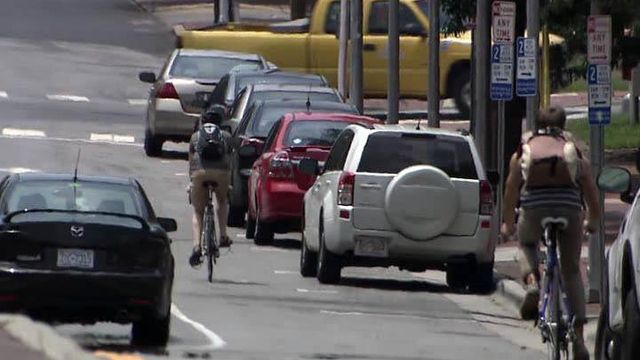Mental health director's death reignites bike-car debate
North Carolina ranks among the top half of the U.S. in fatality rates for bicyclists, and a Wednesday crash that killed the state director of mental health services has reignited the debate over four- and two-wheeled vehicles sharing local roads.
Posted — UpdatedSteven Laverne Jordan, 49, of Raleigh, was killed when an empty logging truck hit him from behind on Louisburg Road north of Perry Creek Road in northeast Raleigh. Jordan had headed the state Division of Mental Health, Developmental Disabilities and Substance Abuse Services since 2010.
The truck driver, Clifton Paul Ellis Jr., 28, of 1715 Richardson Bass Road in Kenly, was charged with misdemeanor death by vehicle and failure to reduce speed to avoid a collision.
North Carolina had the 23rd-highest fatality rate for bicyclists in 2009, the latest year in which statistics are available. The National Highway Transportation Safety Administration reports that 16 cyclists were killed on state roads that year, or 1.71 per 1 million residents.
Yet, the League of American Bicyclists has given North Carolina the title of "bicycle-friendly."
Drivers and cyclists agree that learning to share the road is paramount to improve safety.
"The population increase with the motorists and the bicycles have changed things dramatically," Don Oster, owner of a bike shop in Cary, said Friday.
Oster said cyclists must follow the same rules as cars – riding with traffic, stopping at lights and signaling when they turn.
"Hand signals do a world of good," he said. "They can certainly inform the motorist what we're doing and give them time to react."
Cyclists said their No. 1 fear is distracted drivers.
"A lot of times, when people are texting and talking on the phone, they're not paying attention. They just see a green light and nothing is coming, so they're going to make the right (turn)," cyclist Donya Parker said.
By law, drivers are supposed to treat bikes like cars, yielding to them when they get too close. But bikers also make drivers nervous.
"Sometimes, they will ride more in the middle of the road than towards the edge, and I certainly don't want to hurt anybody," driver Aubrey Poe said.
"I've also, on the flip side, seen bicyclists that take chances when they try to ride ride three or four across, abreast when they're on a single-lane road. It makes it a little tough on the drivers as well," driver Ken Hoadley said.
Cyclists say bike lanes create a safer environment for both riders and drivers, but there aren't enough of them in the area.
Truck driver Andre Simmons said he does what he can to avoid bicyclists.
"It makes me a little nervous when I see them on the side of the road," Simmons said. "I try to slow down and ease over."
Ellis told police that traffic in the center lane of northbound Louisburg Road prevented him from shifting over to avoid Jordan. Investigators determined that Ellis didn't move enough or slow down enough to avoid hitting him.
Oster said both cyclists and drivers need to have a better understanding of each other.
"We need to all share the road and use good common sense," he said.
• Credits
Copyright 2024 by Capitol Broadcasting Company. All rights reserved. This material may not be published, broadcast, rewritten or redistributed.






